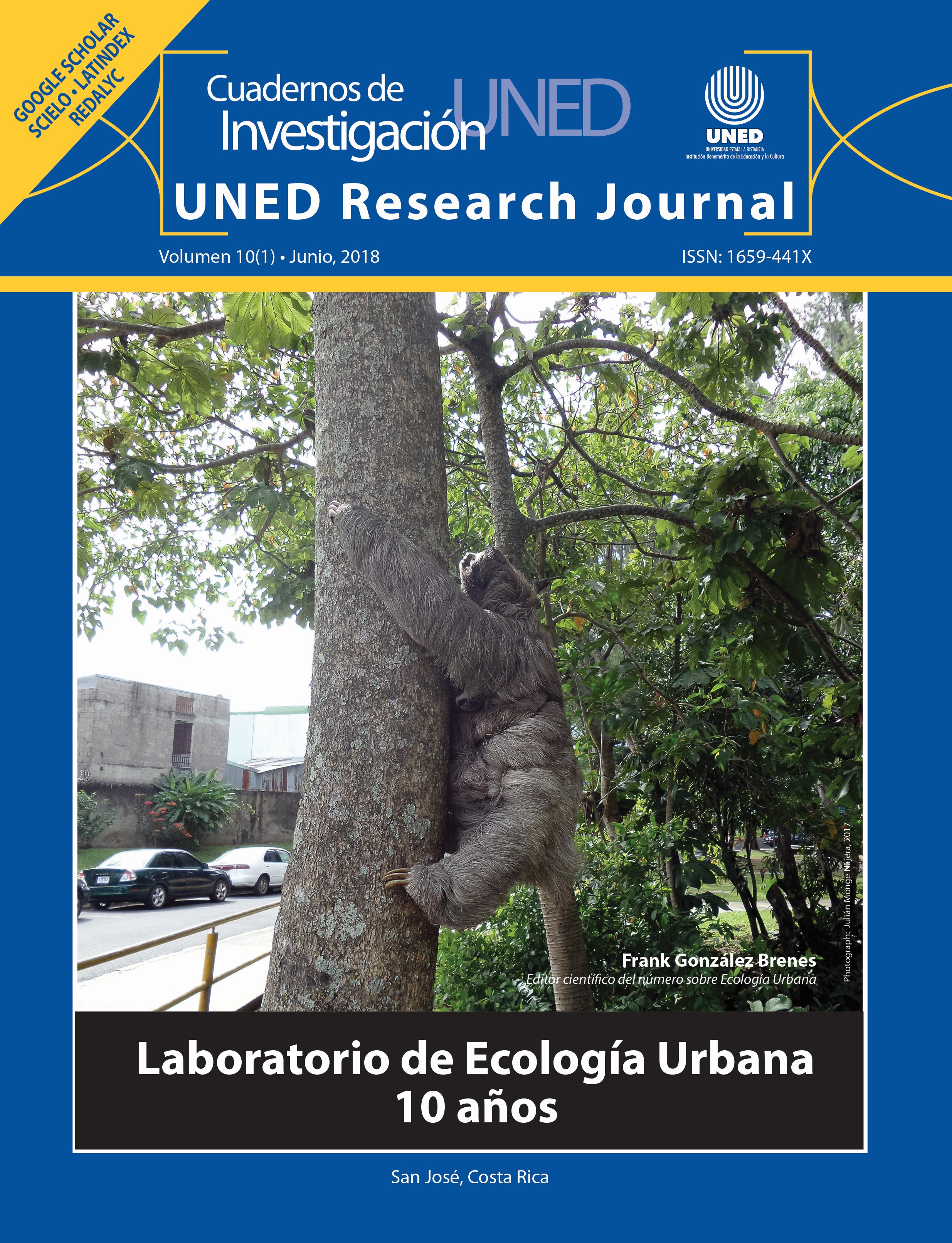Decálogo ético para la reintroducción de especies en hábitats urbanos
DOI:
https://doi.org/10.22458/urj.v10i1.2048Palabras clave:
relación ética con la naturaleza, ciudades como ecosistema, restauración de ecosistemas, tratamiento humanitario de los organismosResumen
La reintroducción de especies a sus hábitats originales -tras haber edificado sobre ellas- será más importante a medida que la urbanización aumente en todo el mundo, pero debe seguir pautas éticas. Aquí propongo diez pautas, las cuales excluyen especies que amenacen la vida humana, la salud y la propiedad; protegen a los organismos del sufrimiento; les proporcionan hábitat y ayuda; incluyen protocolos experimentales y se fundamentan en información recopilada con rigor científico.
Citas
Barrientos, Z. (2013). ¿Cómo restaurar zonas verdes en ciudades tropicales? Ambientico, 232-233, 81-87.
Dickman, A. J. (2010). Complexities of conflict: the importance of considering social factors for effectively resolving human–wildlife conflict. Animal conservation, 13(5), 458-466. doi: 10.1111/j.1469-1795.2010.00368.x
Drayton, B., & Primack, R. B. (2012). Success rates for reintroductions of eight perennial plant species after 15 years. Restoration Ecology, 20(3), 299-303. doi: 10.1111/j.1526-100X.2011.00860.x
Elliot-Hogg, E. (2014). A tale of two cities: coexisting with coyotes in an urban environment. Thesis. Lincoln, New Zealand: Lincoln University.
Haensch, S., Bianucci, R., Signoli, M., Rajerison, M., Schultz, M., Kacki, S., ... & Carniel, E. (2010). Distinct clones of Yersinia pestis caused the black death. PLoS pathogens, 6(10), e1001134. doi: 10.1371/journal.ppat.1001134
Hannon, E. R., & Hafernik, J. E. (2007). Reintroduction of the rare damselfly Ischnura gemina (Odonata: Coenagrionidae) into an urban California park. Journal of insect conservation, 11(2), 141-149.
IUCN (2013). Guidelines for Reintroductions and Other Conservation. Translocations. Gland, Switzerland: Species Survival Commission of the IUCN.
Löe, J., & Röskaft, E. (2004). Large carnivores and human safety: a review. AMBIO: a journal of the human environment, 33(6), 283-288. doi: 10.1579/0044-7447-33.6.283
Maschinski, J., & Duquesnel, J. (2007). Successful reintroductions of the endangered long-lived Sargent’s cherry palm, Pseudophoenix sargentii, in the Florida Keys. Biological Conservation, 134(1), 122-129. doi: 10.1016/j.biocon.2006.07.012
Seddon, P. J., Armstrong, D. P., & Maloney, R. F. (2007). Developing the science of reintroduction biology. Conservation biology, 21(2), 303-312. doi: 10.1111/j.1523-1739.2006.00627.x
Treves, A., & Naughton-Treves, L. (1999). Risk and opportunity for humans coexisting with large carnivores. Journal of Human Evolution, 36(3), 275-282. doi: 10.1006/jhev.1998.0268
Van Langevelde, F., & Wynhoff, I. (2009). What limits the spread of two congeneric butterfly species after their reintroduction: quality or spatial arrangement of habitat? Animal Conservation, 12(6), 540-548.
Vieira, B. P., Fonseca, C., & Rocha, R. G. (2015). Critical steps to ensure the successful reintroduction of the Eurasian red squirrel. Animal Biodiversity and Conservation, 38(1), 49-58.
Wilson, C. J. (2004). Could we live with reintroduced large carnivores in the UK?. Mammal Review, 34(3), 211-232. doi: 10.1111/j.1365-2907.2004.00038.x
Wimberger, K., Downs, C. T., & Perrin, M. R. (2009). Two unsuccessful reintroduction attempts of rock hyraxes (Procavia capensis) into a reserve in the Kwa Zulu-Natal Province, South Africa. South African Journal of Wildlife Research, 39(2), 192-201. doi: 10.3957/056.039.0213
Descargas
Publicado
Cómo citar
Número
Sección
Licencia
Nota: Este resumen contiene un copyright incorrecto debido a problemas técnicos. Los autores que publican en esta revista aceptan los siguientes términos: Los autores conservan los derechos de autor y otorgan a la revista el derecho de primera publicación, con la obra simultáneamente bajo una Licencia de Atribución de Creative Commons que permite a otros compartir la obra con el reconocimiento de la autoría y la publicación inicial en esta revista.
Los contenidos se pueden reproducir citando la fuente según la licencia de Acceso Abierto CC BY 4.0. El almacenamiento automático en repositorios está permitido para todas las versiones. Incentivamos a los autores a publicar los datos originales y bitácoras en repositorios públicos, y a incluir los enlaces en todos los borradores para que los revisores y lectores puedan consultarlos en cualquier momento.
La revista está financiada con fondos públicos a través de la Universidad Estatal a Distancia. La independencia editorial y el cumplimiento ético están garantizados por la Comisión de Editores y Directores de Revistas de la UNED. No publicamos pautas publicitarias pagadas ni recibimos financiamiento de la empresa privada.
